

Code of Conduct on Images & Messages. The Live Aid Legacy. Do aid campaigns skew the debate? A new report on attitudes to aid throws down a challenge to policymakers and campaigners in the way they communicate with the public on international development.
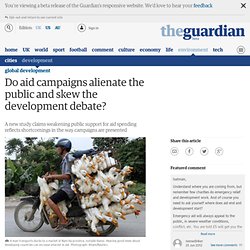
The report from the Overseas Development Institute (ODI) and the Institute for Public Policy Research said its findings support recent opinion polls showing a drop in support for increased aid spending in austerity Britain. This erosion of public support may explain the coalition government's reluctance to enshrine in law an election pledge to spend 0.7% of its national income on international aid.
NGOs 'engaging' or 'marketing'? The lessons from Make Poverty History. Kirsty McNeill is a consultant who served on the co-ordination team of Make Poverty History Strengths: Populism.

If your theory of change is based on getting huge numbers of people to act, you need to find them. Make Poverty History's single most important strategic decision was to be mass-market, creating moments that nervous politicians and the swing voters couldn't ignore. IDS film examines how British media portray Global South. A new short film from IDS reveals how the British media portray poverty in developing countries.
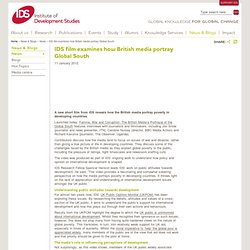
Launched today, Famine, War and Corruption: The British Media’s Portrayal of the Global South features interviews with journalists and filmmakers, including Jon Snow (journalist and news presenter, ITN), Caroline Nursey (director, BBC Media Action) and Richard Kavuma (journalist, The Observer, Uganda). Contributors discuss how the media tend to focus on issues of war and disaster, rather than giving a true picture of life in developing countries. The Worf effect and NGO rhetoric « Aid Thoughts. Today is a good day to fight poverty!
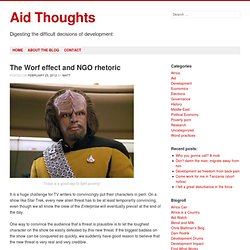
It is a huge challenge for TV writers to convincingly put their characters in peril. THE AFRICANIZATION OF POVERTY: A RETROSPECTIVE ON ‘MAKE POVERTY HISTORY’ The Role of Brand in the Nonprofit Sector. Many nonprofits continue to use their brands primarily as a fundraising tool, but a growing number of nonprofits are developing a broader and more strategic approach, managing their brands to create greater social impact and tighter organizational cohesion.

Nonprofit brands are visible everywhere. Amnesty International, Habitat for Humanity, and World Wildlife Fund are some of the most widely recognized brands in the world, more trusted by the public than the best-known for-profit brands.1 Large nonprofits, such as the American Cancer Society and the American Red Cross, have detailed policies to manage the use of their names and logos, and even small nonprofits frequently experiment with putting their names on coffee cups, pens, and T-shirts. Branding in the nonprofit sector appears to be at an inflection point in its development.
The Bill & Melinda Gates Foundation, for example, recently appointed Tom Scott as director of global brand and innovation. Global Health Communications Round 9. Grand Challenges Explorations Round 9February 2012 In Partnership with the Cannes Lions International Festival of Creativity The Challenge: Many people in the developed world are aid weary.
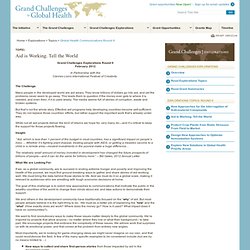
They know billions of dollars go into aid, and yet the problems never seem to go away. This leads them to question if the money ever gets to where it is needed, and even then, if it is used wisely. Africans as Animals in the Western Imagination. I have always felt an inexplicable discomfort when conversations about Africa turn to the topic of wildlife.
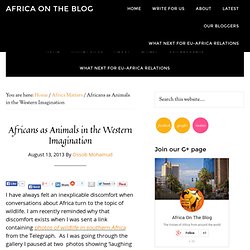
I am recently reminded why that discomfort exists when I was sent a link containing photos of wildlife in southern Africa from the Telegraph. Photographs for Africa. Conflicts, poverty, disease and misery, these, unfortunately, remain the staples of many foreign photojournalists covering the continent of Africa.
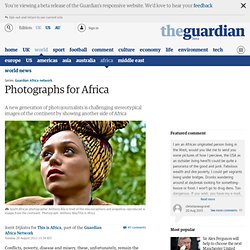
Heartbreaking images just sell a lot better then pictures of ordinary Africans doing what people all over the world do: simply living. This was one of the points artist/documentary maker Renzo Martens was trying to make in the following clip in which he explains to Congolese photographers how they can earn more money from international media houses. Renzo, roughly translated, says to the photographers: "You earn one dollar a month [with wedding, birthday and anniversary photographs]. But photos of rape victims, corpses, and malnourished children fetch up to 1,000 dollars a month. " Starvation Photography – The ethics of capturing human suffering.
23/07/2011 at 9:22 am.

Ethics and Photography in Developing Countries. Enroll in the Cultural Competency Certificate Program Introduction Those who take photos while participating abroad have an ethical responsibility to preserve the dignity of their subjects and provide a faithful, comprehensive visual depiction of their surroundings so as to avoid causing public misperceptions.

Visual images are a cogent way to convey an experience to an audience and to evoke strong public emotions, as people often formulate their opinions, judgments, and behaviors in response to visual stimuli. In this way, the photographer wields substantial control over public perception. Photographers’ decisions about how to depict their subjects can entirely alter viewers’ perceptions.
Ethical Considerations. The stereotype of the ‘African’ child. Images of impoverished children are regularly associated with stories about both ‘Africa’ and famine, even if the issue of famine in question is not specifically or only related to ‘Africa’. In this recent business story (June 2010) about the relationship between the demand for biofuels and rising food prices, a naked child with distended belly represents the threat for famine.
(Interestingly, the on-line version of the story was illustrated with a photograph of Somali’s protesting rising prices in 2008). A stereotype is something preconceived or oversimplified that is constantly repeated without change. Stereotypes involve icons, which are figures that represent events or issues. Binyavanga Wainaina: Rewriting Africa - Talk to Al Jazeera. It is time to change our image of Africa. Critics say that for too long now, aid organisations, foreign diplomats, politicians and journalists have been stuck looking at this vast continent as a convenient photo-opportunity to illustrate victimhood and desperation. And few men are more forceful in advocating a change in how we perceive Africa than Kenyan author Binyavanga Wainaina.
The danger of a single story. The dangers of a single story Chimamanda Adichie warns of misconceptions from just one story about a people or nationShe says a single story can deny some people their humanity, complexityShe cites how Africa, America, the poor have been stereotyped this wayAdichie found her own voice when she stopped imitating books she read as a child Editor's note: Chimamanda Ngozi Adichie has written, among other works, the acclaimed novels "Purple Hibiscus" and "Half of a Yellow Sun" and the short-story collection "The Thing around Your Neck.
" The Nigerian author attended Johns Hopkins and Yale universities and divides her time between Nigeria and the United States. (CNN) -- Nigerian author Chimamanda Adichie believes in the power of stories, and warns that hearing only one about a people or nation leads to ignorance. She says the truth is revealed by many tales. Adichie also tells how growing up in Nigeria reading only American and English children's books made her deaf to her authentic voice.
Iconography of childhood. The Key Role of Imagery and Messaging for Irish NGO’s. Live chat – Development with dignity: how to talk aid. Social media and the near ubiquity of the internet have made it possible for development organisations to communicate their messages via more platforms than ever before.
But as these groups focus more on being heard and found by their audiences, the traditional anti-poverty messaging has become increasingly contested. Critics have condemned the use of "poverty porn" – what Michael Whittemore, founder of the Centre for Global Engagement, describes as "humanitarian organisations ... leveraging images of poverty, disease, and famine to access charitable donations".
But this, Whittemore adds, is changing, and the recently launched If campaign is a good example. 'African' TV about Europe. ‘Suffering Africa’ media spoof wins over one million viewers. A music video that mocks the patronising and misguided appeals for Africa has been viewed by more than one million people. How to Write about Africa :-) This article was originally published in Granta 92. Always use the word ‘Africa’ or ‘Darkness’ or ‘Safari’ in your title. Subtitles may include the words ‘Zanzibar’, ‘Masai’, ‘Zulu’, ‘Zambezi’, ‘Congo’, ‘Nile’, ‘Big’, ‘Sky’, ‘Shadow’, ‘Drum’, ‘Sun’ or ‘Bygone’.
Norwegian NGO Spoofs NGO Calls for Aid. Radi-Aid: It's for a good cause.. Radi-aid: Spoof charity single asks Africans to donate radiators to Norway. Who ever said Norwegians don't have a sense of humor? The truth behind the famine pictures that break your heart - Analysis, Opinion. Updated 01 December 2012 02:29 AM. The over-simplified narrative of the Somali famine. Frames & Values: promoting public engagement. How Attitudes Form, Change Behavior. Finding Frames: New ways to engage. When NGDOs say “engaging with the public”, they mean getting their money through marketing & advertisement? UK civil society recently engaged in remarkable reflections on roles of NGOs in a changing environment (e.g. the Smart CSOs initiative), and particularly on the question of how to engage with the public on issues which go beyond the people’s immediate self-interest.
When Will NGOs Invest in Patient Communications? Children upset by shock tactics in campaigns. Martin Hickman – Updated 02 December 2012 11:00 AM. Reframing Global Poverty: Martin Kirk on Finding Frames. Building Support for International Development. View an infographic summary of research findings from each country in the Build Support study. Watch video from the Building Support Project launch event including a presentation of research findings and Q&A session. Communicating Complexity.